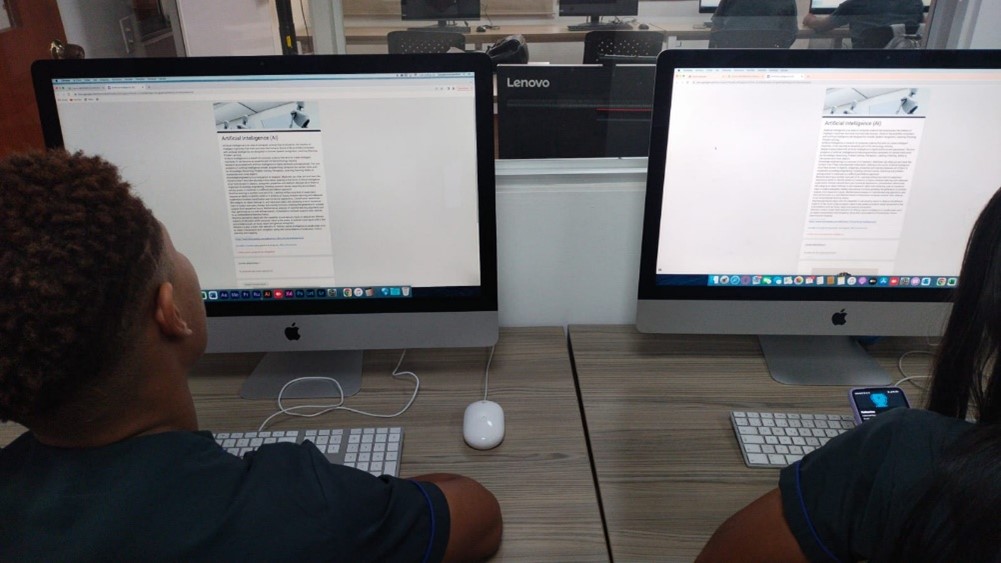Techno-Pedagogical Report on the use of Artificial Intelligence tools at the University
Published 5 November 2023

Photo by: Fernando Naranjo
The emergence of Artificial Intelligence based on usage models, such as the recognition and generation of texts, contexts and images based on simple questions.
Abstract
At the end of 2022, there was a great technological disruption that, until now, has made us leave aside such interesting topics in education as the metaverse, blockchain and even the internet of things that dominated the technological landscape in different sectors. This fact was the emergence of Artificial Intelligence based on usage models, such as the recognition and generation of texts, contexts and images based on simple questions.
This article focuses on the academic strategy of using LLMs (Large Language Models) as one of the strongholds of artificial intelligence that are currently in greatest use for the generation of texts, images and content of all types, from from the simple expression of prompts.
The use cases presented here attempt to unleash didactic strategies, mediating the students’ knowledge, based on their own consultation dynamics with these artificial intelligence models, providing a particularized appropriation, despite the fact that they are common constructions, within the framework. of resources requested in the subjects of Information Management and Knowledge Management, belonging to the Department of Educational Informatics, of the Faculty of Engineering and Basic Sciences of Areandina.
The exercise is the result of the request of the academic vice-chancellor’s office to share the experiences that have arisen with the use of these instruments among the educational community and, based on this, a series of initiatives aimed at to show them, including a very successful Forum and successive talks across the spectrum of university interactions.
KeyWords
Artificial Intelligence, Large Language Models, Text Console, Chat
Introduction or General Context
Here we analyze the potential of ChatGPT, a language model powered by artificial intelligence, to transform education. The Educational Informatics department of Pereira, Colombia, has used ChatGPT in various subjects, with positive results.
In the field of algorithms, it has allowed students to transform algorithm problems into programming code in a more intuitive and efficient way. This saves time and gives students a deeper understanding of algorithm fundamentals. In numerical analysis, ChatGPT has helped students understand mathematical models and how they apply in real situations. The tool provides precise answers and adapts to the student’s level of knowledge.
In the subject of Knowing, it has been used to create study material, such as questionnaires and tests. This saves educators time and allows for wide diversity in question types. In addition to these specific applications, ChatGPT has the potential to revolutionize education in several ways. For example, it can be used to solve math problems, generate language teaching content, and create visual study materials.
However, the use of artificial intelligence in education raises a number of ethical and pedagogical questions. It is important to address concerns related to privacy, data security, and equity in access to these technologies. Additionally, the overreliance on artificial intelligence in education raises questions about the continued role of educators and human interaction in the educational process.
Methodology
The importance of asking purposeful questions and providing context to improve the effectiveness of communication with AI is discussed.
LLM technology, based on advanced language models, has revolutionized the way we interact with machines. However, to get the most out of this technology, it is vital to ask questions with a clear purpose. Purposeful questions are those that are asked specifically, allowing AI to understand the user’s intent and thus provide the most useful answers. Instead of asking ambiguous or general questions, it is more effective to ask questions like “What are the current trends in the implementation of artificial intelligence in higher education?”

In addition to asking purposeful questions, it’s also important to provide context. This helps AI understand user intent and generate more specific and relevant responses. For example, in the question above, additional context could be provided, such as “This speaks from the perspective of a higher education professor.” Interaction with AI is constantly evolving. The “Prompts Engineer” role is an example of how users can optimize their communication with AI for more effective and accurate results. This professional is dedicated to refining the questions asked of the AI by providing context examples that guide the chatbot in the desired direction.
It is important to note that, although the AI professional can improve interaction with the tool, it is not a substitute for a deep understanding of users. Every technology has its limitations and cannot replace human knowledge. Successful interaction with AI depends on effective collaboration with the users who nurture it.
Discussion of results
Three main challenges are identified:
- The relevance of traditional tasks: AI can automate many tasks that were traditionally assigned to students, such as solving mathematical problems or writing essays. This raises the question about if these tasks are still relevant in a task-driven educational environment.
- Teachers’ role as guardians of originality: AI can efficiently generate content, raising concerns about the originality of academic works and the possibility of plagiarism. This raises a new question of whether teachers should take a more active role in detecting and preventing plagiarism.
- The need to develop new teaching methodologies: AI offers the possibility of personalizing education, adapting it to the individual needs of students. This requires educators to develop new teaching methodologies that make the most of their potential.
It is concluded that the disruption caused by AI in higher education is inevitable. To take advantage of the opportunities that AI offers, it is essential that educators, institutions and students adapt to change.
Conclusions
In the analysis of the use of ChatGPT in the educational field, great benefits are identified:
Helps overcome creative block and procrastination. ChatGPT can generate ideas and content quickly and efficiently, which can help students overcome a lack of inspiration or motivation. But it can also generate content with a certain context of originality, since it is trained on a large corpus of text and code, which allows it to generate high-quality content.
However, the author also points out that ChatGPT can have some drawbacks if not used properly: It can foster dependency and disengagement. Students can become dependent on LLMs, which can lead to a lack of effort and reflection, plus, as mentioned before, it can be difficult to detect plagiarism, or to distinguish it from human-written text, which would lead to academic integrity issues.
It is argued that AI, in its LLM aspects, can be valuable tools in the educational field, but it is important to use it responsibly. ChatGPT should be used as a complement, not a substitute, for creativity and critical reflection.
Thanks
Without paying attention to the actors who have accompanied us on this itinerary, some of our teams are mentioned that I manage to remember more vividly, the family of Informática Educativa Pereira, the partners of Informática Educativa Bogotá, the vital support of the Faculty of Engineering and Basic Sciences, to our friends who are leaders in Teaching Development, always pushing us towards more achievements in the construction of didactics and, especially, to our Vice, architect and promoter of innovative initiatives, to everyone and to those who remain to be mentioned, thank you, thanks, thanks…
References
- OpenAI. (2022, November 22). Chatgpt. ChatGPT. https://openai.com/chatgpt
- Google. (2023, May 15). Bard – chat based AI tool from Google, powered by Palm 2. https://bard.google.com/chat
- Araque-Peñaranda, A., Rodríguez-Hernández, J., & Rodríguez-Hernández, Y. (2023). ChatGPT en la educación: Análisis de su potencial y limitaciones. Revista de Investigación Educativa, 41(1), 1-22. doi:10.22201/ie.20072872e.2023.1.7244
- Cano, M., & García-Peñalvo, F. J. (2022). ChatGPT: Un modelo de lenguaje para la educación. Revista Complutense de Educación, 33(1), 155-170. doi:10.5209/rcedu.65071
- García-Peñalvo, F. J., & Cano, M. (2022). ChatGPT para la formación docente. Revista de Educación a Distancia, 27(63), 1-20. doi:10.6018/red/374501



